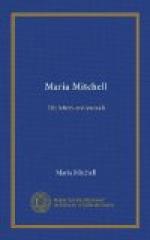After their removal to the bank building there were added to these an “altitude and azimuth circle,” loaned to Mr. Mitchell by West Point Academy, and two transit instruments. A little observatory for the use of the first was placed on the roof of the bank building, and two small buildings were erected in the yard for the transits. There was also a much larger and finer telescope loaned by the Coast Survey, for which service Mr. Mitchell made observations.
At the time when Maria Mitchell showed a decided taste for the study of astronomy there was no school in the world where she could be taught higher mathematics and astronomy. Harvard College, at that time, had no telescope better than the one which her father was using, and no observatory except the little octagonal projection to the old mansion in Cambridge occupied by the late Dr. A.P. Peabody.
However, every one will admit that no school nor institution is better for a child than the home, with an enthusiastic parent for a teacher.
At the time of the annular eclipse of the sun in 1831 the totality was central at Nantucket. The window was taken out of the parlor on Vestal street, the telescope, the little Dolland, mounted in front of it, and with Maria by his side counting the seconds the father observed the eclipse. Maria was then twelve years old.
At sixteen Miss Mitchell left Mr. Peirce’s school as a pupil, but was retained as assistant teacher; she soon relinquished that position and opened a private school on Traders’ Lane. This school too she gave up for the position of librarian of the Nantucket Atheneum, which office she held for nearly twenty years.
This library was open only in the afternoon, and on Saturday evening. The visitors were comparatively few in the afternoon, so that Miss Mitchell had ample leisure for study,—an opportunity of which she made the most. Her visitors in the afternoon were elderly men of leisure, who enjoyed talking with so bright a girl on their favorite hobbies. When they talked Miss Mitchell closed her book and took up her knitting, for she was never idle. With some of these visitors the friendship was kept up for years.
It was in this library that she found La Place’s “Mecanique Celeste,” translated by her father’s friend, Dr. Bowditch; she also read the “Theoria Motus,” of Gauss, in its original Latin form. In her capacity as librarian Miss Mitchell to a large extent controlled the reading of the young people in the town. Many of them on arriving at mature years have expressed their gratitude for the direction in which their reading was turned by her advice.
Miss Mitchell always had a special friendship for young girls and boys. Many of these intimacies grew out of the acquaintance made at the library,—the young girls made her their confidante and went to her for sympathy and advice. The boys, as they grew up, and went away to sea, perhaps, always remembered her, and made a point, when they returned in their vacations, of coming to tell their experiences to such a sympathetic listener.




